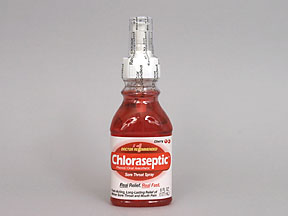
Chloraseptic Coupons & Savings Card – Discount Prices from $7.62
Our Chloraseptic coupons are free to use. You can print the coupon, email it to yourself, or receive the Chloraseptic coupon via text message. To get your free discount, show the pharmacist your Chloraseptic savings card which has the discounted coupon price. Use our filters below to edit the prescription box to match your needs. The Chloraseptic prices will update based on your prescription needs. Above our Chloraseptic coupons, you can change the location to see pharmacy prices in other areas. Our prescription discount card will update online with the specific pharmacy costs associated with your edits. Be sure to text, email, or print the Chloraseptic savings card code that you need after editing the prescription box and location field. Show the discount card to your pharmacist before paying.
My prescription
Edit
177ML of 1.4%, Chloraseptic (1 Bottle)
Select pharmacy

Albertsons
$7.62
COUPON PRICE
Walgreens
$8.83
COUPON PRICEChloraseptic savings card
Show this card to your pharmacist
Albertsons
$7.62
BIN
ID
PCN
GRP
011867
LH3D6DE49A
HT
LABH001
Powered by
Our Chloraseptic coupons are free to use. You can print the coupon, email it to yourself, or receive the Chloraseptic coupon via text message. To get your free discount, show the pharmacist your Chloraseptic savings card which has the discounted coupon price. Use our filters below to edit the prescription box to match your needs. The Chloraseptic prices will update based on your prescription needs. Above our Chloraseptic coupons, you can change the location to see pharmacy prices in other areas. Our prescription discount card will update online with the specific pharmacy costs associated with your edits. Be sure to text, email, or print the Chloraseptic savings card code that you need after editing the prescription box and location field. Show the discount card to your pharmacist before paying.
Our Chloraseptic coupons are free to use. You can print the coupon, email it to yourself, or receive the Chloraseptic coupon via text message. To get your free discount, show the pharmacist your Chloraseptic savings card which has the discounted coupon price. Use our filters below to edit the prescription box to match your needs. The Chloraseptic prices will update based on your prescription needs. Above our Chloraseptic coupons, you can change the location to see pharmacy prices in other areas. Our prescription discount card will update online with the specific pharmacy costs associated with your edits. Be sure to text, email, or print the Chloraseptic savings card code that you need after editing the prescription box and location field. Show the discount card to your pharmacist before paying.
Chloraseptic FAQs
Using the SaveHealth discount card, what is the price of Chloraseptic without insurance?
Using the SaveHealth discount card, the price of Chloraseptic without insurance is $7.62.
What is the price of Chloraseptic at Walgreens?
The price of Chloraseptic at Walgreens is $8.83.
